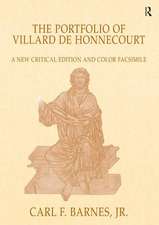The Image of Political Power in the Reign of Nerva, AD 96-98
Autor Nathan T. Elkinsen Limba Engleză Hardback – 31 aug 2017
Preț: 574.23 lei
Preț vechi: 824.18 lei
-30% Nou
Puncte Express: 861
Preț estimativ în valută:
109.88€ • 115.05$ • 91.14£
109.88€ • 115.05$ • 91.14£
Carte tipărită la comandă
Livrare economică 31 martie-05 aprilie
Preluare comenzi: 021 569.72.76
Specificații
ISBN-13: 9780190648039
ISBN-10: 0190648031
Pagini: 224
Ilustrații: 91 illus.
Dimensiuni: 239 x 152 x 18 mm
Greutate: 0.48 kg
Editura: Oxford University Press
Colecția OUP USA
Locul publicării:New York, United States
ISBN-10: 0190648031
Pagini: 224
Ilustrații: 91 illus.
Dimensiuni: 239 x 152 x 18 mm
Greutate: 0.48 kg
Editura: Oxford University Press
Colecția OUP USA
Locul publicării:New York, United States
Recenzii
E., an associate professor of art history (Greek and Roman) at Baylor University, argues in this fascinating and attractively produced book that a significant clue to answering the above question, which he largely does in Nerva's favour, lies in the study of the coinage issued during his reign. As a numismatist E show boundless enthusiasm and prodigious learning.
[A] welcome look at what does survive from Nerva's reign.... Elkins makes a strong case for connecting the imagery of Nerva's coinage to the laudatory ideals expressed in contemporary poetry and rhetoric, offering us a new perspective on Nerva's reign. By examining the frequency of types among hoards and excavated finds as well as their locations, the author makes a convincing case for audience targeting in the issuance of the coin types. Historians, art historians, and numismatists will find much to think about in this book.
Throughout the book, Elkins displays a masterful command of the numismatic evidence and contemporary scholarship.
[O]ffers a wide range of readers new food for thought about the production and consumption of Nerva's image across the Roman empire, reading the rhetoric on coinage in dialogue with other material culture, literary texts and elite discourse ... For many today Nerva remains a bit of a blank, a two-dimensional figure to whom it is easy to attach clichéd assumptions. Elkins' book presents a thoughtful counterbalance.
An excellent, detailed study of late first century CE Roman coin types, distribution patterns, and the dynamic roles of mint officials. Elkins' work is a must-have for scholars and students alike interested in Roman numismatics and political iconography produced during the brief but critical reign of Nerva.
This book is essential for any student of the late first century AD. Rejecting received opinions of Nerva's principate, based on hostile writers, Elkins uses the coinage of Nerva himself, subjects it as a medium of art (akin to the poetry, panegyric, inscriptions and monuments lacking for this short reign) to thorough and sophisticated analysis and finds in it nothing apologetic. This is a different Nerva from the weak and failing emperor of the few works previously devoted to him. But Elkins' book has a wider scope. Putting Nerva up against predecessors and successors and finding him presented just as confident and unassailable as they entails discussion, no less illuminating, of notorious problems such as 'propaganda,' the emperor's role in choosing coin types, and the elucidation of imperial 'virtues.'
A much needed reassessment of Nerva's reign through the lens of coinage. Elkins provides new insights into the coinage of Nerva, and sets the ideology of this period in context.
[A] welcome look at what does survive from Nerva's reign.... Elkins makes a strong case for connecting the imagery of Nerva's coinage to the laudatory ideals expressed in contemporary poetry and rhetoric, offering us a new perspective on Nerva's reign. By examining the frequency of types among hoards and excavated finds as well as their locations, the author makes a convincing case for audience targeting in the issuance of the coin types. Historians, art historians, and numismatists will find much to think about in this book.
Throughout the book, Elkins displays a masterful command of the numismatic evidence and contemporary scholarship.
[O]ffers a wide range of readers new food for thought about the production and consumption of Nerva's image across the Roman empire, reading the rhetoric on coinage in dialogue with other material culture, literary texts and elite discourse ... For many today Nerva remains a bit of a blank, a two-dimensional figure to whom it is easy to attach clichéd assumptions. Elkins' book presents a thoughtful counterbalance.
An excellent, detailed study of late first century CE Roman coin types, distribution patterns, and the dynamic roles of mint officials. Elkins' work is a must-have for scholars and students alike interested in Roman numismatics and political iconography produced during the brief but critical reign of Nerva.
This book is essential for any student of the late first century AD. Rejecting received opinions of Nerva's principate, based on hostile writers, Elkins uses the coinage of Nerva himself, subjects it as a medium of art (akin to the poetry, panegyric, inscriptions and monuments lacking for this short reign) to thorough and sophisticated analysis and finds in it nothing apologetic. This is a different Nerva from the weak and failing emperor of the few works previously devoted to him. But Elkins' book has a wider scope. Putting Nerva up against predecessors and successors and finding him presented just as confident and unassailable as they entails discussion, no less illuminating, of notorious problems such as 'propaganda,' the emperor's role in choosing coin types, and the elucidation of imperial 'virtues.'
A much needed reassessment of Nerva's reign through the lens of coinage. Elkins provides new insights into the coinage of Nerva, and sets the ideology of this period in context.
Notă biografică
Nathan T. Elkins is Associate Professor of Art History (Greek and Roman) at Baylor University. He is a Fellow of the American Numismatic Society (New York) and a Fellow of the Royal Numismatic Society (London).





